Common House Spiders (With Pictures) – Identification Guide
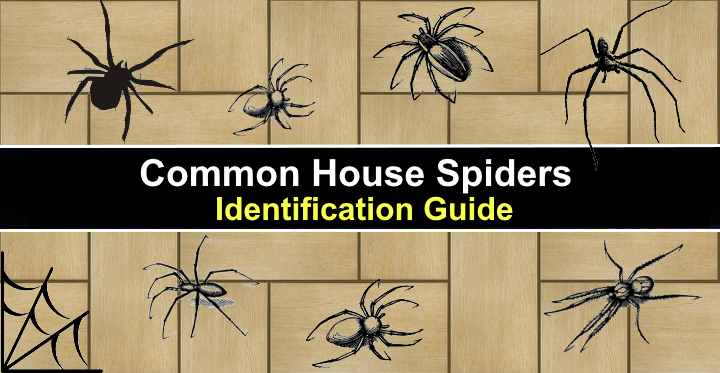
House spiders are common in many homes throughout the country. Despite this fact, most people cringe at the sight of a common house spider. Seeing a black or brown arachnid scampering across the floor or lurking in a dark corner can send you into a panic. There is also the fear that the house spider is dangerous and could inflict a nasty bite. Thankfully, most common house spiders are harmless.
Identifying spiders commonly found in homes is vitally important. Although most house spiders are not venomous, the common house spider is easily mistaken for the dangerous brown recluse. Additionally, the furry brown or black jumping spider looks frightening with its hairy body and white spots, but it is generally not harmful.
This article is a guide to identifying common types of spiders you are likely to find in your home. Descriptions and pictures of the eight-legged creepy crawlers will help you know the spider species and how to deal with them.
How to Identify Common House Spiders
House spider is a term for several Arachnida species typically found in homes. Identifying features of common house spiders are their eight legs, body shape, distinctive markings, color, and presence of hairs. Most house spiders are brown and hairless. However, the black widow with its distinctive red hourglass marking is an exception.
Another identifying feature of common house spiders is their webs. For example, the common house spider and black widow spin cobwebs or tangled webs. In addition, some outdoor spiders like orb weavers can make their way indoors and spin intricate webs, creating a spoked, open web to trap insects.
Types of Common House Spiders (With Pictures) – Identification Guide
Identifying common house spiders is a great way to ensure you handle them correctly. Although most spiders in homes don’t bite and are not dangerous, there are a few exceptions. Please continue reading to learn more about common indoor house spiders.
American House Spider (Parasteatoda tepidariorum)
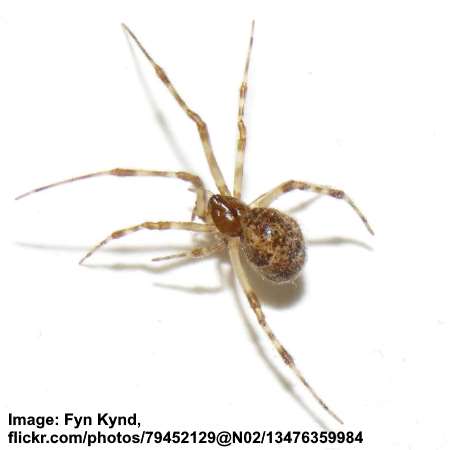
The American house spider is commonly found indoors and is identified by its bulbous brown mottled body and long legs
The American house spider is a common tan to dark brown spider. The small brown spider has a bulbous abdomen, long legs, and the appearance of a brown widow spider. The brown female spiders measure 0.2” to 0.24” (5 – 6 mm) long.
Due to their brown color, the American house spider is difficult to spot indoors. Signs of these common indoor spiders are messy cobwebs in corners of window frames, ceilings, and furniture.
Like all spiders, the American house spider is venomous. However, it is classed as a harmless indoor brown spider because it’s not aggressive and only bites if you grab or squeeze it. Additionally, the toxins in the venom aren’t dangerous to humans.
House Spider Identification
Identifying features of the common American house spider are its bulbous dark brown body with mottled patterns, long creamy-white and tan legs, and a small, brown-colored head.
Where To Find the Common House Spider
American house spiders are common in corners of rooms, window frames, and furniture. You’ll also find them in dark places like attics, crawl spaces, under furniture, and sheds.
The American house spider is common in homes from Florida in the south to the northeastern and northwestern United States.
Black House Spider (Badumna insignis)
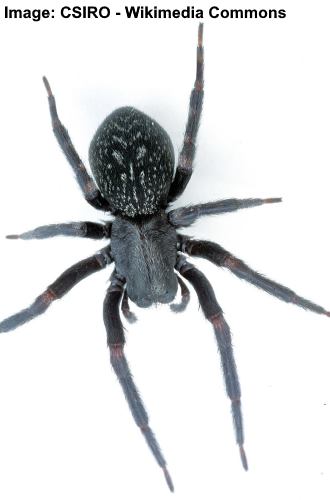
The black house spider is a robust black spider with a wide body, relatively fat legs, and dark charcoal-gray body
The black house spider is a robust spider with a dark, charcoal-gray abdomen and white speckles. In addition, the spider has a characteristic velvety blackish-gray body and furry legs. Its large, egg-shaped abdomen and color give it the appearance of a tarantula. Black house spiders measure 0.7” (18 mm) long.
The black house spider is also related to the gray house spider (Badumna longinqua). This species is slightly smaller and has a pale gray body and legs. Both spider species spin funnel webs to catch their prey. However, the furry house spiders are relatively timid and tend to avoid contact with humans.

Gray house spider (Badumna longinqua)
House Spider Identification
The black house spider is identified by its dark gray to black oval abdomen covered in tiny white markings. Also, the spider has a huge leg span of 1.1” (28 mm), making it appear larger.
Where To Find the Common House Spider
You’ll often find the black house spider lurking in wall crevices, crawl spaces, behind baseboards, and window frames.
Cellar Spider (Pholcidae)
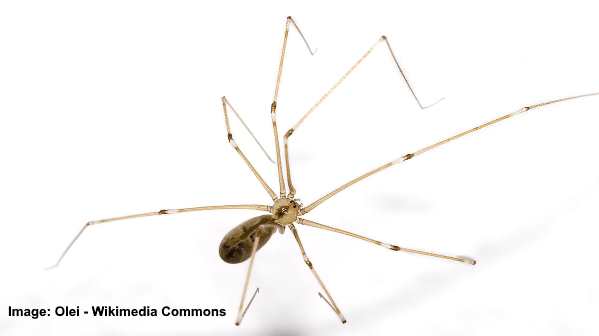
Cellar spiders are common house spiders with long thin legs that like to live in dark places
The cellar spider is easy to spot in homes because of its long spindly legs and tiny, egg-shaped, brown body. Although this small brown spider only measures 0.08” to 0.39” (2 – 10 mm), it has an enormous leg span of 2” (50 mm). In addition, the small spider has six eyes arranged in groups of three.
Cellar spiders are common in houses throughout North America and are completely harmless. However, you may notice the small spider with its thin arching legs in the corner of rooms. These spiders spin messy, irregular-shaped webs high up in corners of rooms and other undisturbed places.
The cellar spider also goes by common names like vibrating spiders, carpenter spiders, and daddy long-legs spider. However, the name daddy long-legs is also given to other arthropods like harvestmen and crane flies.
House Spider Identification
The cellar spider is a harmless, brown spider with a small rounded abdomen and long thin tan-colored legs.
Where To Find the Common House Spider
Cellar spiders are commonly found in attics, basements, crawl spaces, and undisturbed corners of rooms.
Southern House Spider (Kukulcania hibernalis)
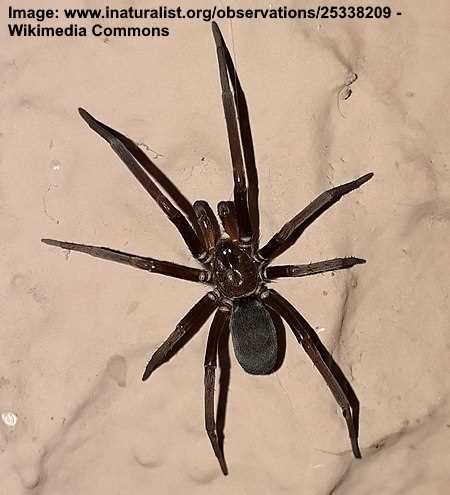
The southern house spider has a dark brown to black appearance and is typically harmless
The southern house spider is a large dark brown to black spider with a large oval head and elongated fuzzy brown abdomen. Up close, pictures of this house spider show it has dark brown spiny legs and two prominent eyes on top of its head. The southern house spider measures up to 0.75” (20 mm) across.
Although common in homes in the southern states, it’s only the male house spiders that are seen. The spiders tend to scurry across floors and can appear aggressive. However, southern house spiders are typically harmless.
Also called crevice weaver spiders, the brown spiders thrive in warm environments.
House Spider Identification
The large brown southern house spider has an oval abdomen with a velvety appearance, a shiny brown cephalothorax, and long furry legs.
Where To Find the Common House Spider
The southern house spider is commonly found in undisturbed basements and attics.
Black Widow Spider

The southern black widow spider (Latrodectus mactans) has a black body with a distinctive red hourglass marking on its underside belly and can be found especially in homes in warm places
The black widow spider is easily recognized by its shiny black body with a red hourglass marking. Black widows with red markings have a bulbous abdomen, long glossy black legs, and a small head. Depending on the species, the abdominal marking on the black spider’s underside can be pinkish, orange, or deep red.
Black widow spiders measure between 0.12” and 0.40” (3 – 10 mm). However, their leg span makes them appear larger. This species of venomous spider can inflict a nasty, venomous bite that can result in muscle pain, cramping, and muscle spasms.
Black widow spiders tend to lurk in dark places and only attack when threatened. Signs of the venomous black spiders are messy cobwebs consisting of sticky fibers.
House Spider Identification
Black widow spiders have a characteristic red hourglass marking contrasting with a shiny black oval, ball-like body. Typically, their two front legs are longer than the other six.
Where To Find the Common House Spider
Inside the homes, black widows usually lurk in dark, dimly lit places like crevices, closets, cluttered areas, basements, and attics.
Black widows can be found in homes throughout the United States, especially in warm states like Arizona, Florida, Texas, and Nevada.
Brown Widow Spider (Latrodectus geometricus)
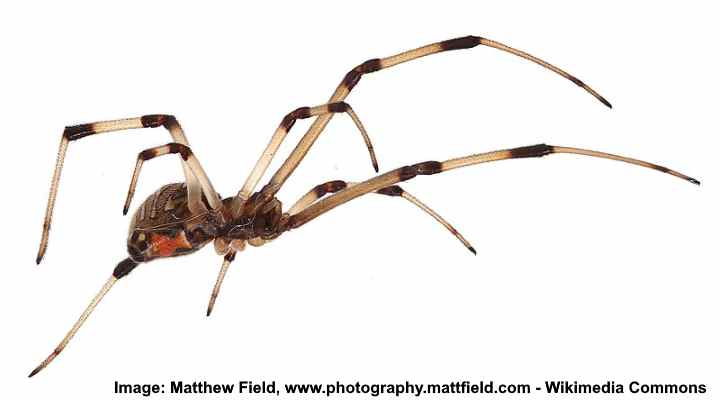
The brown widow spider has a dark striped back and dark orange hourglass marking on its underside and likes dark places in the house
The brown widow spider is a venomous spider with a bulbous light brown to dark brown body and distinctive hourglass marking on the side of its abdomen. The brown widow’s markings can be orange or dull yellow, and it also has colorful markings on its back.
Brown widow spiders measure 0.47” – 0.6” (12 – 16 mm) long, making them slightly smaller than black widows. Like all widow spiders, the brown widow has long, extended legs that are tan with dark brown bands.
Although venomous, the brown widow spider’s bite isn’t as severe as the black widow. Most people compare it to a bee’s sting.
House Spider Identification
The easily recognizable feature of the brown widow spider is its orangey-red geometric hourglass marking on its side, banded tan legs, and colorful stripes across its brown abdomen.
Where To Find the Common House Spider
Brown widow spiders are typically found in dark, undisturbed areas of your home like behind furniture, basements, attics, or garages.
Brown widow spiders are also found in yards under rock piles, wood piles, and other sheltered areas. These brown spiders are common in Arizona, Florida, California, and other southern states.
Brown Recluse Spider (Loxosceles reclusa)
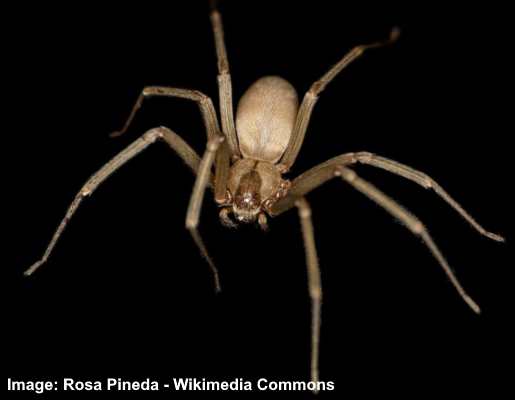
The brown recluse is a venomous house spider with light brown body and long legs
Brown recluse spiders are a species of venomous house spiders commonly found indoors. The brown, biting spiders have a tan to medium brown body with a recognizable violin-shaped marking on their cephalothorax. Brown recluse spiders measure 0.24” to 0.8” (6 – 20 mm) long. However, their leg span makes them appear larger.
Other names for the brown recluse spider include brown fiddler, violin spider, or fiddleback spider. Although the violin markings on its head are an identifiable feature, other harmless spiders also have similar markings. However, a unique characteristic of the brown spider is that it has six, not eight, eyes like most spiders.
House Spider Identification
A brown recluse spider has a yellowish-brown velvety head and oval abdomen. In addition, the six-eyed spider has a distinctive violin pattern on its cephalothorax, making it easy to distinguish from the common house spider.
Where To Find the Common House Spider
The brown recluse spins disorderly webs and inhabits dark, quiet places in homes, typically where there is cardboard. These web-weaving spiders usually come out at night to hunt.
Wolf Spider (Lycosidae)
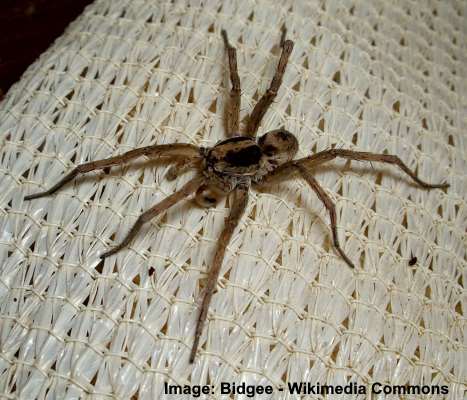
Wolf spiders have brown body with black stripes and can enter homes when the weather becomes cooler
Wolf spiders are furry brown spiders with distinctive black bands on their abdomens. Identifying features of wolf spiders are their eight eyes arranged in three rows, banded furry legs, and a flattened head. The medium-sized brown spiders grow 0.4” to 1.4” (10 – 35 mm) in size.
Where To Find the Common House Spider
Wolf spiders typically live outdoors, but the furry brown spiders can enter homes in the fall when the temperature drops. They prefer hiding in crevices, closets, around doors, and basements.
Hobo Spider (Eratigena agrestis)
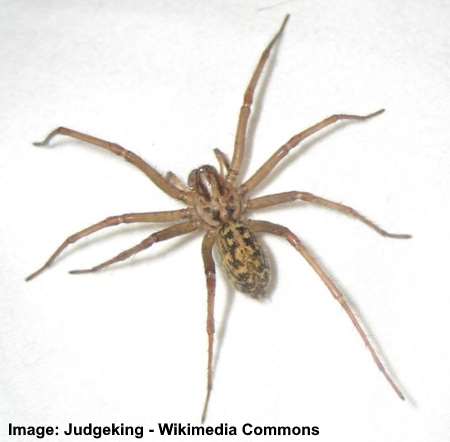
Hobo spiders are fast moving and are common in northwestern United States homes
Hobo spiders are a type of brown funnel web spider with distinctive chevron, V-shaped patterns on their abdomens. Identifiable features of hobo spiders are two dark stripes and one lighter stripe on the cephalothorax, light brown legs with no bands, and visible spinnerets at their posterior.
Hobo spiders measure 0.27” to 0.55” (7 – 14 mm) long. Usually, noticing a hobo spider in the home causes panic because there are incredibly agile, swift-moving spiders.
Where To Find the Common House Spider
Hobo spiders are common in houses in the northwestern United States. They enter homes through cracks in the fall and will find dark, damp places to hide. They are often found in basements, under bathtubs, or in wall crevices.
Jumping Spider (Salticidae)
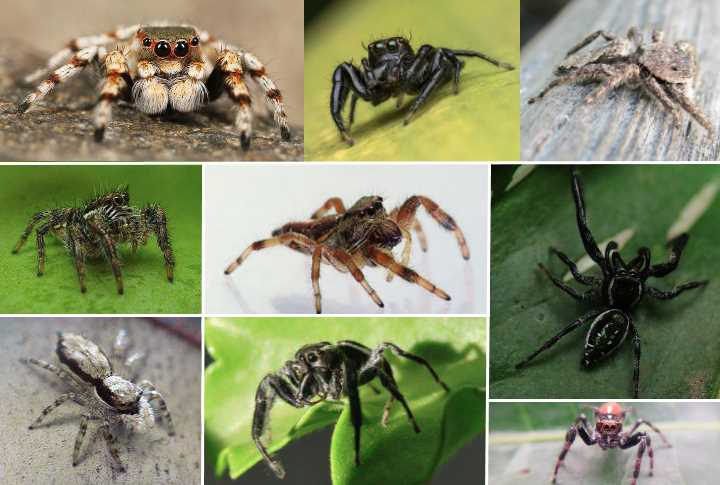
Jumping spiders are common house spiders which include many species with various colors and markings
Jumping spiders are a group of spiders with many species. Some of them are small furry black spiders with white dots. Jumping spiders are identified by their black, tan, or gray bodies with orangish or white markings. They are also covered in dense hairs and have thick, short legs, giving them a scary appearance. Another feature is their eight eyes in three rows, with two prominent eyes in the center.
There are thousands of species of jumping spiders with common characteristics. They can run fast and quickly move from side to side. The small, white-spotted spiders measure 0.04” to 1” (1 – 25 mm) long.
Where To Find the Common House Spider
Jumping spiders are usually found near windows and doors as they hunt for small insects to consume.
Northern Yellow Sac Spider (Cheiracanthium inclusum)
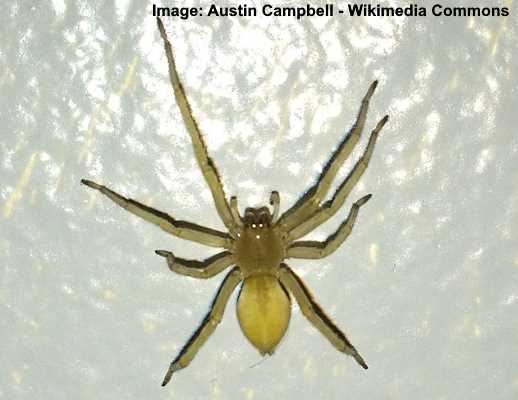
Northern yellow sac spiders are commonly found in gardens, but come inside homes in cold weather
The northern yellow sac spider is a type of garden spider that sometimes finds its way into homes. This small yellow spider has an identifiable egg-shaped abdomen with a pointed end and dark brown markings on its face and the tips of its legs. The small yellow house spider can measure 0.19” to 0.35” (5 – 9 mm) with a leg span up to 1” (25 mm).
Also called the black-footed spider, yellow sac spiders can inflict a painful venomous bite.
Where To Find the Common House Spider
In the house, the yellow sac spider typically lives in the corners of walls and ceilings, where it stays undisturbed. You may also find them under window sills. However, they are usually in gardens, hiding under foliage, boards, leaf litter, and stones. Therefore, it’s always best to use gloves when working in the garden.
Orb Weaver Spiders (Araneidae)
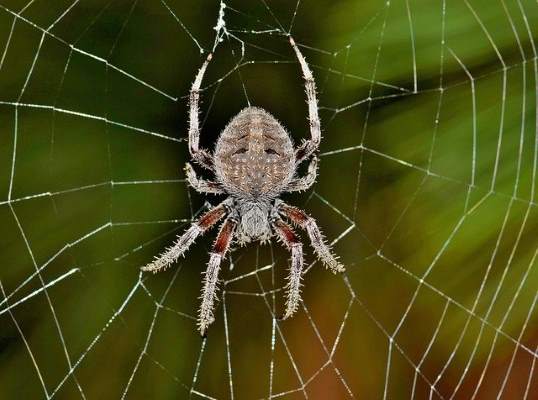
Orb weaver spiders include many species that vary in color and size and occasionally find their way indoors
Orb weaver spiders are a type of outdoor spider that can hide in structures like the patio and decking around your home. The large hairy spiders typically have a furry brown, oval abdomen with black or white spots, spiny legs, and a relatively small head. Orb weaver spiders grow 0.78” to 1.18” (20 – 30 mm) long.
Where To Find the Common House Spider
Non-aggressive orb weaver spiders only occasionally find their way into homes. However, you will notice them due to the large, sheet-like spoked webs they spin.
American Grass Spiders (Agelenopsis)
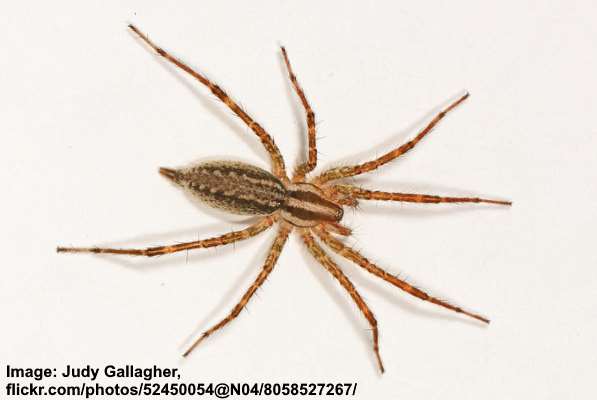
The American grass spider has a light brown body with dark brown stripes and brown patterns and is rarely found in homes
American grass spiders are a type of brown funnel weaver spider with an elongated, oval brown body. Identifying features of the grass spiders are the distinctive dark brown bands running down its cephalothorax, mottled brown abdominal patterns, and spiny, orangey legs. American grass spiders grow up to 0.78” (20 mm) long.
The American grass spider sometimes finds its way into homes; however, that is rare. So if you see a brown spider in your home, the chances are that it’s a common house spider or a brown recluse.
Harvestmen (Opiliones)
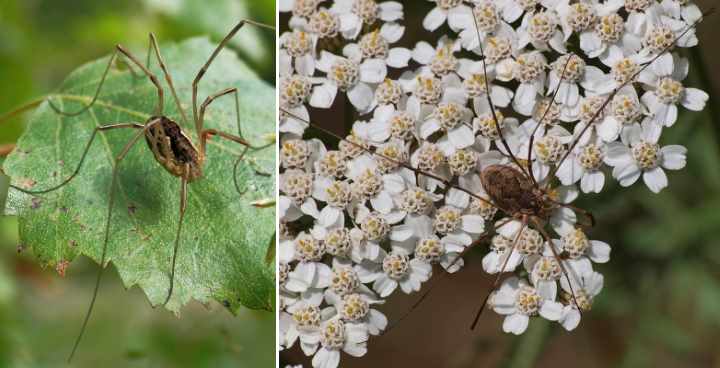
The spider-like arachnoid harvestmen are similar to cellar spiders and are also called daddy longlegs
Harvestmen is a large order of spider-like arachnoids with thousands of species in the order. Harvestmen are typically small brown creatures with long, delicate arching legs. Some harvestmen species have brown bodies with a mottled pattern on their backs. Other harvestmen “spiders” are brown with yellow dots.
Although technically not classed as a true spider, harvestmen have many of the characteristics of spiders. Usually, harvestmen are small, with their bodies not growing more than 0.28” (7 mm) long. However, they have a characteristic large leg span, sometimes up to 6.3” (160 mm) in length.
Harvestmen don’t spin webs and have poor eyesight. Instead, they use their front legs as antennae and hunt small insects.
House Spider Identification
Harvestmen are easily recognizable by their small round bodies and eight exceedingly long legs. In addition, you can tell harvestmen apart from spiders because they have a fused body.
Where To Find the Common House Spider
You’ll often find harvestmen in sheds, garages, basements, and crawl spaces.
Related articles:
